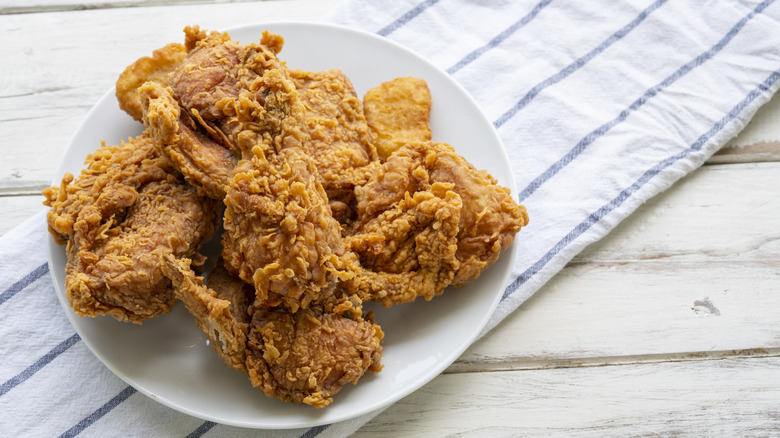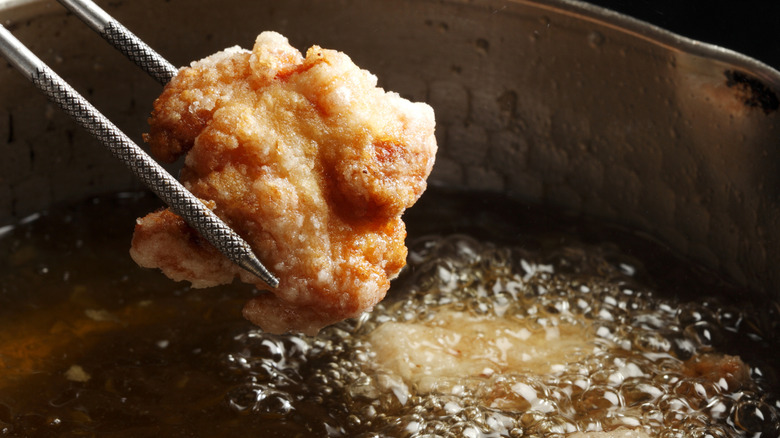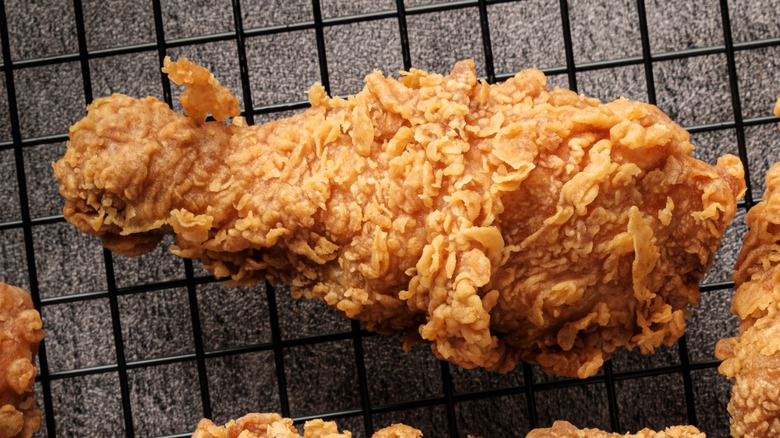Why You Should Start Double-Frying Fried Chicken
For the fried chicken enthusiast, making the stuff at home can feel like a never-ending quest for that perfect equilibrium between crispy, shattering crunchiness on the outside and a meaty, juicy bite within. From golden tumeric fried chicken in Malaysia to variations in Korea and Ethiopia, it seems like every culture has its own techniques that chefs swear by for making the perfect version of this comfort food. But one common thread that crops up frequently among all the delicious international styles of fried chicken is a simple trick that you should be using at home — double-frying. With the right dredge and a little care and attention, you'll be well on your way to the most delicious fried chicken you've ever made in no time.
In the same way that restaurants often double-cook (or, if you're Heston Blumenthal, triple-cook) their fries, the two-step cooking process is simultaneously more effective at crisping up the exterior of your chicken, while providing a gentler, more even cook for the meat itself. The result is consistently juicy, tender chicken without having to sacrifice your coating (which can sometimes burn before the chicken has had a chance to fully cook through, leaving you with a bitter, unappetizing mess). The secret is frying your chicken at a lower temperature the first time around, allowing the meat to gently cook, before resting, then giving it a rapid blast of intense heat that'll crisp up the coating on the outside before the meat itself has a chance to overcook.
The science of how it works
Double-frying is a relatively simple process, scientifically speaking: And it all has to do with water. You'll notice when you deep-fry anything, take french fries, for example, that when they first enter the oil, lots of little bubbles form — it's what creates that sound that usually signals we're about to chow down on something crispy and delicious. You might think that it's the oil that's bubbling away, but you'll never really get oil anywhere near its boiling point when cooking at home (and if you do, it's probably time to make a run for it). Those bubbles are actually caused by water rapidly evaporating from the surface of whatever it is that you're cooking. Water is the enemy of crispiness, so it's important to evaporate all that liquid from the surface. But with a single, solitary fry, sometimes the chicken is well overcooked by the time that's done.
The double fry negates this problem – that first fry doesn't just provide a gentler, more forgiving cook for the chicken, it also serves to evaporate the initial layer of moisture from its surface. Then, as the meat rests, any excess water on the surface evaporates, meaning that chicken is primed to immediately begin getting extra crisp during that second, high-temperature fry. In short, the chicken spends less time directly in contact with the heat, cooks more evenly, and comes out much, much crispier.
How long you should you rest your chicken and other FAQs
When it comes to resting your chicken after the first fry, how long to rest it is really up to you — but a good guideline is that once you remove it from the oil (the first time), you'll want to leave it to rest at room temperature for at least half an hour prior to giving it a second fry. This will allow enough time for any excess moisture to evaporate from the surface as well as allow carry-over cooking to do its job and ensure you get that even doneness (and avoid overcooking). Just make sure that you don't leave the chicken out at room temperature for more than two hours. Any longer than that and you'll risk it becoming unsafe to eat. If you do want to prep your chicken more than two hours in advance, just stick it in the fridge, where it can even sit overnight.
Speaking of leaving your chicken overnight, you can use the double-fry method as inspiration and give your fried chicken leftovers a new lease of life the next day with a quick fry. In fact, the chicken may even turn out more delicious than when you first had it! To keep your chicken crispier for longer, place it in a warm oven (but not too warm, think 200 degrees Fahrenheit) on a rack — this'll allow any excess oil to run off, preventing things from getting soggy for the crispiest crust you can possibly get.



